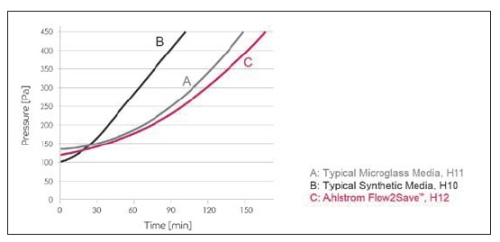
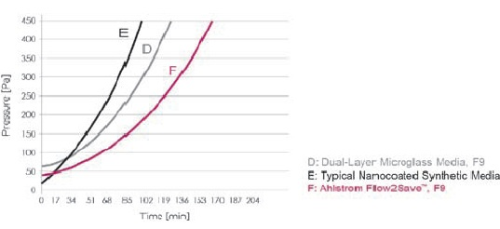

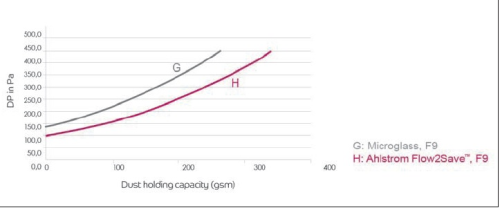
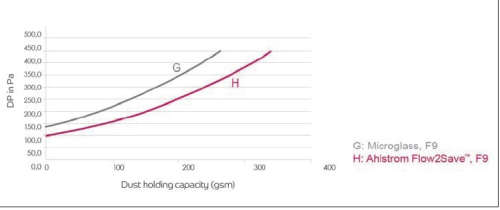
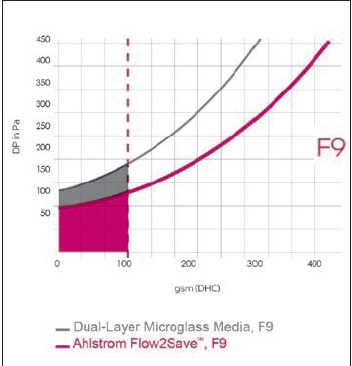
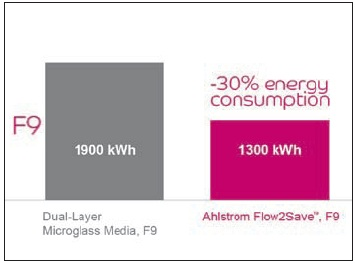
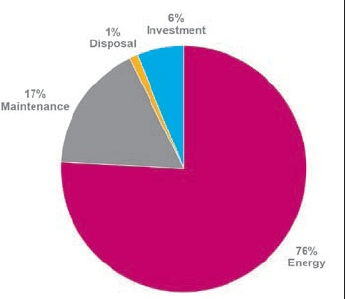

Heating, Ventilation and Air Conditioning (HVAC) filters can provide high particulate removal capability, but these filters also create significant airflow resistance. As a result, high-efficiency HVAC systems require powerful fans to move air, consuming tremendous energy and producing CO2 emissions. The US Department of Energy estimates that buildings account for approximately 40% of the nation’s overall energy consumption, and 40% of all US greenhouse gas emissions. As much as 40% of that consumption is from HVAC systems.
Ahlstrom’s Flow2Save filtration media was launched at the FILTECH exhibition in Germany in October this year. Flow2Save is a patent-pending media for High Efficiency Air (HEA) filtration applications such as indoor air environments.
Flow2Save is based on an engineered gradient structure combining multiple advanced media technologies and is available at efficiency levels from F7 upwards, per test standard EN779-2012, and for HEPA levels per EN1822. The use of Ahlstrom’s Flow2Save media enables filter manufacturers to positively impact customers’ life quality, by supporting a basic need – providing clean indoor air.
Background
Traditionally, HEA filtration has been readily available only to the most critical environments, as a result of challenging equipment requirements and high operating costs. Media with high filtration efficiency usually exhibit high pressure drop. The ventilation system of a building pulls dirty air from the building, pushes it through the filters and the building’s duct system, and returns the clean air to the building.
Many ventilation systems are not powerful enough to push air through filters with high pressure drop characteristics. The pressure drop of a filter therefore may become the limiting factor to Indoor Air Quality (IAQ), and thus negatively affect quality of life. This is a critical challenge for the application of HEA in typical commercial and residential buildings.
The industry-wide accepted tests to characterize HVAC filter quality in terms of particle size and efficiency performance are EN779 in Europe and ASHRAE standard 52.2 in the US. Another important aspect of filter media performance, its functional quality in terms of energy usage, relating to the pressure drop of the media and filter construction, is addressed in classification Eurovent 4/11.
Eurovent 4/11 has helped drive design, manufacture and commercialisation of filters requiring ever decreasing energy consumption. In recent years, most filter manufacturers have developed at least one filter model in the F7 to F9 class that meets the energy consumption criteria of filter class A according to Eurovent 4/11. Table 1 references the filter classification per Eurovent 4/11 for classes A through G. As filters get more energy efficient, a further distinction of class A into new classes may be necessary.
While actual filter design is important and filter manufacturers can greatly influence filtration performance through optimised pleat geometry, manufacturing quality, size and number of panels, etc., the quality and performance of the filter media itself directly translates into the quality and performance of the filter.
Glass media is the gold standard for HEA filtration, as it has been the only media that reliably delivers filtration efficiency at the level of F7 or higher according to EN779, with 100% mechanical filtration. Synthetic media with charged components such as electrostatically-charged Meltblown or Dry-laid webs do not keep their efficiency performance over the lifetime of the filter, as they gradually discharges depending on multiple environmental factors. EN779-2012 attempts to address this important differentiation, which is critical for cleanrooms, hospitals and other high-end applications, by requiring an additional efficiency test after Isopropanol discharge.
Recently, new synthetic media are emerging in the market based on Spunbond or Dry-laid media with nanofibers. While nanofibers can offer high filtration efficiency that stays consistent over the lifetime of the filter, they also tend to plug the media and increase pressure drop very quickly, and require the construction and use of an elaborate and thick pre-filter layer. This behaviour typically results in low dust holding capacity and short filter life of filters that use nanofibers to achieve high-efficiency filtration.
Experimental – Media Evaluation
With a unique engineered design and patent-pending construction, Ahlstrom Flow2Save delivers both lower initial pressure drop and slow pressure drop increase with dust loading over the lifetime of the filter.
Figure 1 and Figure 2 show typical pressure drop curves for HEA media, as measured on flat sheets with a Palas MFP3000 test stand.
In Figure 1, line A is the pressure drop curve of a typical high efficiency glass media of H11 efficiency class, as measured with a Palas MFP3000 test instrument. The test was run with PTI Fine Test Dust at 75 mg/m3 feed, at a face velocity of 5.3 cm/s. The media has an initial pressure drop of 135 Pa. Line B shows a typical commercially available synthetic media of H10 efficiency class.
The initial pressure drop is 106 Pa, but the pressure drop increases much faster than with the H11 glass media. After a test time of less than 25 minutes, the synthetic media has reached the same pressure drop as the glass media. Pressure drop then dramatically increases as the media is plugged under dust load, while the glass media maintains a good open pore structure under dust load.
Curve C shows the pressure drop curve of Ahlstrom's Flow2Save, passing efficiency level H12. Initial pressure drop is 118 Pa, and pressure drop rises slowly with dust feed, similar to the glass media. It is notable that not only does the media have a lower pressure drop throughout the usage time, but also reaches the highest efficiency level purely by means of mechanical filtration.
Figure 2 shows a similar scenario at the F9 efficiency level. Curve D shows the pressure drop curve of a commercial glass media with an initial pressure drop of 60 Pa. This is a dual-layer, advanced engineered media with F9 efficiency. Line E depicts the pressure drop of a synthetic F9 media, showing a low initial pressure drop of 25 Pa, but a steep rise in pressure drop with dust load as time progresses.
Curve F shows the pressure drop of the Flow2Save, starting with an initial pressure drop of 45 Pa and rising slowly throughout the operating time of the media. This behaviour demonstrates the excellent depth filtration characteristics of the new media, which allow for long filter life at sustained filtration efficiency at F9 level.
The Flow2Save was also tested with soot as a contaminant. Figure 3 shows the pressure drop curves for the same media D, E and F in comparison, resulting from a soot test using contaminant oil JIS#2, at face velocity 5.3 cm/s.
Experimental – Filter Data
Ahlstrom has manufactured and tested prototype filters with Flow2Save to understand how the media advantages translate into benefits in High Efficiency air filters. While specific filter designs as used by its customers may further improve performance results and benefits, the company chose as standard V-bank filter to fit 24 inch x 24 inch ducts as commonly used for cleanrooms or hospitals. The prototype filters have 8 panels, and look like the filter depicted in the picture below.
The filters were tested according to EN779:2012, at a volume flow of 3400 m3/h. The resulting pressure drop curves for F9 efficiency are depicted in Figure 4. Curve G shows the pressure drop for an F9 V bank filter made of microglass, and curve H shows the pressure drop for an F9 filter of the exact same design made of the Flow2Save. It can be seen immediately that these curves correspond well to the pressure drop curves for the flat sheet media, as already discussed in Figure 2.
As required for the F9 efficiency rating per EN779, the filter also showed very good particle removal efficiency as demonstrated in Figure 5.
In order to determine the impact on energy consumption, the energy was calculated for the filters tested, according to Eurovent 4/11 .........................
----- PLEASE SEE FIGURE 9 -----
As required in the calculation, a 4th order polynominal was used to model the pressure drop and determine the fit parameters a, b, c and d.
For practical purposes, the Eurovent 4/11 calculation means that the energy consumption of the filter is determined based on the integral area under the pressure drop curve, as depicted in Figure 6.
It can be seen that this area is significantly lower for the Flow2Save filter than for the Microglass filter, which is confirmed by the calculated numbers for energy consumption during one year, per Eurovent 4/11.
Experimental – Life Cycle Analysis
In order to further quantify the benefits of Flow2Save, Ahlstrom performed an extensive Life Cycle Analysis of the filter from cradle-to-use phase. Detailed investigation of raw materials, processing throughout the manufacturing value chain and usage revealed that the filter usage phase contributes at over 98% to the monitored sustainability factors, which are Global Warming (CO2 Emissions), Non-renewable Energy Consumption, Resource Scarcity and Water Consumption.
The life cycle cost of a filter can be broken down as depicted in Figure 8. The initial investment includes the capital cost of the filter, frame and installation, and contributes about 6%. Further costs to be considered are maintenance cost, which represents the cost of replacement filters and labour, and cost to dispose of the used filters. By far the largest cost contribution however, is the energy cost of the system necessary to power the fan, making up 76% of the total cost.
As was calculated earlier based on Figure 7, energy consumption of a filter made from Flow2Save is approximately 30% lower than with a traditional commercial filter of the same efficiency rating. This energy savings directly translates into a 30% cost savings, allowing significant monetary savings potential for building installations requiring a multitude of filters.
Conclusions
Ahlstrom's Flow2Save is a new filter media for high efficiency air applications with advantageous pressure drop characteristics to allow for significant energy savings during use. The media is carefully engineered to provide both excellent fine particle filtration and an effective pre-filter mechanism that insures optimized pressure drop behaviour not only at the beginning of the filter use or test, but throughout the life of use of the media. This is achieved strictly by mechanical filtration mechanisms at efficiency classes F7 through H12 according to EN779:2012 and EN1822.
Flow2Save makes it easier for the ventilation system to push air through the filter while keeping filtration efficiency at the same high level. Following the Eurovent 4/11 guidelines we have demonstrated that Flow2Save creates energy savings of more than 30% compared to a standard commercial Microglass media at the same efficiency level. This relates to monetary savings of several hundred Euros over the lifetime of the filter thanks to lower energy consumption.
It also opens doors towards higher indoor air quality for a broader range of buildings, for example to better protect children from pollutants in school classrooms. The sustainability credentials of Flow2Save are compelling; it allows for a healthier environment with cleaner indoor air quality, a 30% lower energy consumption compared to Microglass media and significant cost savings throughout the life cycle.






